CURRENT PROJECTS
CURRENT PROJECTS
Optical Patterning of Nanomaterials for Quantum Information
Optically addressable defects have emerged as a promising platform for quantum information devices. These typically consist of point defects in wide-band gap semiconductors that can be optically initialized, manipulated, and read out via tailored waveguides. High fidelity in each of these steps is critical to realizing a quantum network. However, the design of optics to realize the accurate optical addressing of these defects remains challenging. Simulations have demonstrated that optimal designs are often inaccessible by traditional design rules. Combining experiment and theory, this project focuses on developing a new scalable platform for high-throughput simulation, production, and characterization of optics that enhance the fidelity of defect initialization, manipulation, and read out.
High-Throughput Design and Testing of Optics for Quantum Devices
Carrier spins and optically addressable dopants in nanomaterials have emerged as promising platforms for quantum information applications. The unique size-dependent optoelectronic properties of nanomaterials offer a tantalizing platform to engineer the coherence, storage, and transmission of information. Colloidal syntheses can produce high-quality nanomaterials with sizes, morphologies, and optical properties that far exceed what is possible with lithography. Despite this promise, quantum technologies have instead relied on lithographically patterned materials because they can be precisely placed into devices.
This project is focused on developing new manufacturing methods to deterministically incorporate nanomaterials into cavities and heterostructures to study how nanocrystal structure and device design combine to influence performance for quantum applications.
Quantum State Engineering with Ultracold Atoms
Using the theory of weak measurement and quantum feedback to engineer stable steady states in ultra cold atomic systems. Simulation of spineless and spinor Bose-Einstein condensates under various quantum control protocols. Simulation of fermionic and bosonic atoms in optical lattices under weak measurement and feedback.
- Feedback induced magnetic phases in binary Bose-Einstein condensates
HM Hurst, S Guo, IB Spielman Physical review research 2 (4), 043325 (2020) - Feedback cooled Bose-Einstein condensation: near and far from equilibrium
EP Yamaguchi, HM Hurst, IB Spielman arXiv preprint arXiv:2206.04156
EPIQ-IT: Engineering Parametric Interactions For Quantum Information Technologies
The primary goal of the Engineered Parametric Interactions for Quantum Information Technology program is to develop parametric interactions between superconducting circuit elements to enable fast, high fidelity quantum gates and qubit readout for multi-qubitcavity systems. Circuit designs that provide parametric interactions between superconducting qubits offer a way to perform high speed quantum gates with very high fidelity, while balancing the requirements for maintaining long qubit coherence times, while eliminating stray interactions. In addition, parametric gates between qubits and cavities provide a means to perform highly controlled fast pulsed, high fidelity qubit measurements. This work focuses on developing the parametric circuits and control methods to ensure high fidelity gates and multiplexed qubit measurements. In addition, with our unique multi-qubit designs, we can characterize the coherence of each qubit separately and correlate these coherence measurements to gather information that could identify decoherence mechanisms and ultimately improve qubit coherence.
Superconducting Qubit Noise Analysis
Study of SC qubit noise to improve read out accuracy. Collaboration with Lawrence Livermore National Laboratory.
PROBING THE ORIGINS OF CHIRALITY INDUCED SPIN SELECTIVITY VIA TRANSPORT MEASUREMENTS
Chirality induced spin selectivity (CISS) generates spin polarization in electron currents passing through a chiral molecule. Since its discovery almost two decades ago, CISS has been experimentally observed in a number of spectroscopic and tunneling magnetoresistance measurements. The theoretical foundations of CISS however, remain a subject of intense debate: helicity, chirality, substrate effects, interface effects, inelastic scattering processes, and many-body effects have all been highlighted as the critical factor governing CISS. One reason for this lack of consensus is that most CISS materials are delicate molecular systems that display spin filtering behavior under exacting conditions. This limits the types of devices these systems can be integrated into for experimental enquiry. Our proposal, premised on the recent discovery of the first semiconducting CISS system (Methylbenzylammonium)2Pb1-xSnxI4, aims to provide some of the key experimental insights needed to consolidate the theoretical foundations of CISS.
Defect States of Silicon Allotropes for Quantum Information Science
The project is focused on advancing the knowledge on critical properties and controls of spin-defect states that are needed for quantum information science materials. The inherent structure and properties of novel crystalline silicon allotropes provides precise interstitial sites for dopants/qubits to sit, along with the potential for low sensitivity to thermal excitation and long spin lifetimes and decoherence times, coupled with a direct bandgap within the telecommunications wavelength. The goals of this project are to design, synthesize, and control the structure-properties of crystalline silicon allotropes with interstitial dopants (inside cages or channels), with controlled defect spin-states with lower sensitivity than diamond Si to thermal excitation and spin relaxation, to mitigate key issues in diamond silicon for revolutionary quantum information science materials.
Electron-phonon processes in gate-defined silicon quantum dots: measurement, control, and applications
Electron-phonon coupling is ubiquitous in Condensed Matter systems. It plays a pivotal role in relaxation and decoherence (in case of multiple spins) of electronic spin states and is predicted to mediate many-body phenomena. An immense body of research on tailoring it in fields as varied as superconductivity and thermoelectrics exists. Insight from these fields has never been applied to experiments in few-spin systems. This is a new and impactful opportunity, since few-spin systems are the fundamental prototype for rationalizing spin dynamics in more complex systems, important for quantum information applications. This project bridges the gap via an experimental effort focused on control and measurement of electron-phonon processes in silicon gate-defined quantum dots.
Entanglement and information in complex networks of qubits
Quantum computers are now approaching a size that will soon perform tasks surpassing the power of today’s fastest classical computers. Attaining the full power of a quantum computer requires high qubit connectivity within the computer, so that information can be transferred, and entanglement can be generated between any two qubits as fast as possible. Our aim is to find out how high qubit connectivity can be used to speed up quantum information processing. This project is focused on mathematical quantum speed limits akin to Lieb-Robinson bounds, optimal entangling protocols for very small or very large number of qubits, and experimental demonstrations of entangling speed limit using solid-state qubits.
Thermoelectric Effects in Superconductor-Ferromagnet Hybrids
This project is focused on measuring thermal and thermoelectric effects in superconductor ferromagnet hybrids. These systems have only recently begun to be examined from the lens of thermal effects and a number of fascinating predictions remain untested.
THERMAL EFFECTS IN QUANTUM SYSTEMS
A material or device whose properties (of interest) cannot be understood without invoking quantum mechanics is known as a quantum system. In the last four decades, quantum systems, particularly nano and mesoscopic systems, have been the focal point of much research. A wealth of fascinating Physics, ranging from superhydrophobicity to artificial atoms, has been explored in these systems. However, most probes of quantum phenomena have focused on charge and spin dynamics. Thermal transport and thermoelectric phenomena have hardly been investigated. Our research is focused on experimentally probing thermal phenomena in nano and mesoscopic systems – especially phenomena in which quantum coherence or quantum statistics plays a role. Developing local, sensitive, on-chip controls and probes of temperature for nano devices forms the backbone of these experiments.
Spin Transfer and Magnetic Effects in Molecular and Nanoscale Systems
Photodriven spin polarization in a variety of systems can be useful for quantum sensing and spintronics applications. We develop and use optically detected magnetic resonance (ODMR) tools to monitor the local response of nitrogen-vacancy centers in diamond and spins in metal-organic systems, to nearby magnetic processes. Electron transport, buildup of fields at materials interfaces, and magnetic proximity effects are examples of processes that can be characterized by ODMR.
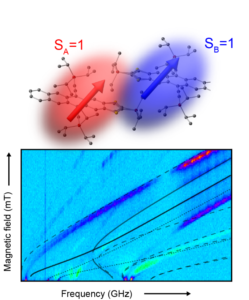
Standard Reference Material for dielectric properties
Establishing and validating via multiple round-robin tests a standard reference material (SRM) for both free-space and on-wafer dielectric measurement calibrations relevant to low loss dielectrics in the low-GHz regime (~0.1 – 18 GHz).
This project aims to develop a NIST-traceable Standard Reference Material (SRM) for dielectric constant and loss tangent.
With the development and rollout of 5G millimeter-wave (mmWave) technology, manufacturers need standards to validate measurements techniques, accept new materials, and for quality assurance. Traceability in low-loss microwave measurements will have important implications in telecommunications and in quantum information.
This project incorporates heavy collaboration with industry for measurement validation and feedback on the design of the standards.
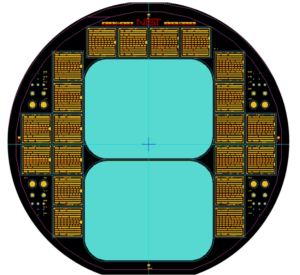
A 4” wafer layout that allows us to laser dice the wafer into components for resonant cavity (blue coupons) and on-wafer (gold transmission lines) measurements of permittivity. The on-wafer measurements are a way to validate the results we get from our resonant cavity measurements and a way to interpolate between the resonance frequencies of those cavities.
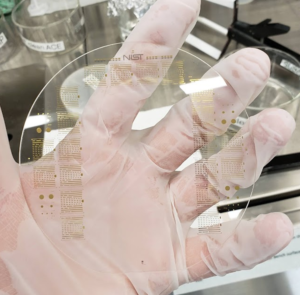
A prototype standard made from a 4” high-purity fused silica wafer with the layout shown in “Picture1” after photolithography. This wafer still needs to be diced before we can make measurements in a resonant cavity or on-wafer.
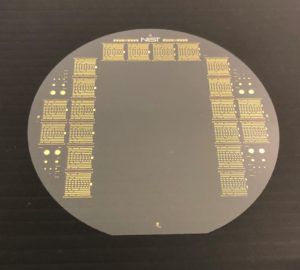
Same as above, just a different angle.
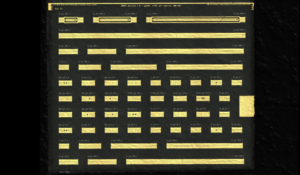
A laser microscope image of one of the on-wafer measurement kits after laser dicing. With these kits, we can use multiline TRL (thru-reflect-line) to extract the material properties of our substrate across a broad frequency range (0.1 GHz – 300 GHz).
Characterization of Two-Level Defects in Superconducting Quantum Devices
This collaboration aims to describe theoretical and experimental characterization of the ueV-scale defects present in materials used for quantum information devices (QIDs). Previous work has focused on eliminating these defects to increase the coherence time and address the scalability problem in QIDs. This work exploits those defects, modeled as two-level systems, to address coherence time and scalability through a novel, bimodal coupling of the ueV defects to an applied microwave field. SJSU collaborators are modeling a device that should demonstrate transduction of electromagnetic energy between modes through controlled excitation of the defects and their subsequent decay. After successful modelling and simulation, Lawrence Livermore National Laboratory will fabricate and characterize the new device. The project is currently in version two of the model with fabrication planned for Spring 2023.
Header image HRTEM image of a sapphire / NbN / MgNbN bilayer stack. Credit: Edwin Supple
Optical patterning of nanomaterials for quantum information
Carrier spins and optically addressable dopants in nanomaterials have emerged as promising platforms for quantum information applications. The unique size-dependent optoelectronic properties of nanomaterials offer a tantalizing platform to engineer the coherence, storage, and transmission of information. Colloidal syntheses can produce high-quality nanomaterials with sizes, morphologies, and optical properties that far exceed what is possible with lithography. Despite this promise, quantum technologies have instead relied on lithographically patterned materials because they can be precisely placed into devices.
This project is focused on developing new manufacturing methods to deterministically incorporate nanomaterials into cavities and heterostructures to study how nanocrystal structure and device design combine to influence performance for quantum applications.
High-throughput design and testing of optics for quantum devices
Optically addressable defects have emerged as a promising platform for quantum information devices. These typically consist of point defects in wide-band gap semiconductors that can be optically initialized, manipulated, and read out via tailored waveguides. High fidelity in each of these steps is critical to realizing a quantum network. However, the design of optics to realize the accurate optical addressing of these defects remains challenging. Simulations have demonstrated that optimal designs are often inaccessible by traditional design rules.
Combining experiment and theory, this project focuses on developing a new scalable platform for high-throughput simulation, production, and characterization of optics that enhance the fidelity of defect initialization, manipulation, and read out.
Quantum State Engineering with Ultracold Atoms
Using the theory of weak measurement and quantum feedback to engineer stable steady states in ultra cold atomic systems. Simulation of spineless and spinor Bose-Einstein condensates under various quantum control protocols. Simulation of fermionic and bosonic atoms in optical lattices under weak measurement and feedback.
- Feedback induced magnetic phases in binary Bose-Einstein condensates
HM Hurst, S Guo, IB Spielman Physical review research 2 (4), 043325 (2020) - Feedback cooled Bose-Einstein condensation: near and far from equilibrium
EP Yamaguchi, HM Hurst, IB Spielman arXiv preprint arXiv:2206.04156
EPIQ-IT: Engineering Parametric Interactions For Quantum Information Technologies
The primary goal of the Engineered Parametric Interactions for Quantum Information Technology program is to develop parametric interactions between superconducting circuit elements to enable fast, high fidelity quantum gates and qubit readout for multi-qubitcavity systems. Circuit designs that provide parametric interactions between superconducting qubits offer a way to perform high speed quantum gates with very high fidelity, while balancing the requirements for maintaining long qubit coherence times, while eliminating stray interactions. In addition, parametric gates between qubits and cavities provide a means to perform highly controlled fast pulsed, high fidelity qubit measurements. This work focuses on developing the parametric circuits and control methods to ensure high fidelity gates and multiplexed qubit measurements. In addition, with our unique multi-qubit designs, we can characterize the coherence of each qubit separately and correlate these coherence measurements to gather information that could identify decoherence mechanisms and ultimately improve qubit coherence.
Superconducting Qubit Noise Analysis
Study of SC qubit noise to improve read out accuracy. Collaboration with Lawrence Livermore National Laboratory.
PROBING THE ORIGINS OF CHIRALITY INDUCED SPIN SELECTIVITY VIA TRANSPORT MEASUREMENTS
Chirality induced spin selectivity (CISS) generates spin polarization in electron currents passing through a chiral molecule. Since its discovery almost two decades ago, CISS has been experimentally observed in a number of spectroscopic and tunneling magnetoresistance measurements. The theoretical foundations of CISS however, remain a subject of intense debate: helicity, chirality, substrate effects, interface effects, inelastic scattering processes, and many-body effects have all been highlighted as the critical factor governing CISS. One reason for this lack of consensus is that most CISS materials are delicate molecular systems that display spin filtering behavior under exacting conditions. This limits the types of devices these systems can be integrated into for experimental enquiry. Our proposal, premised on the recent discovery of the first semiconducting CISS system (Methylbenzylammonium)2Pb1-xSnxI4, aims to provide some of the key experimental insights needed to consolidate the theoretical foundations of CISS.
Defect States of Silicon Allotropes for Quantum Information Science
The project is focused on advancing the knowledge on critical properties and controls of spin-defect states that are needed for quantum information science materials. The inherent structure and properties of novel crystalline silicon allotropes provides precise interstitial sites for dopants/qubits to sit, along with the potential for low sensitivity to thermal excitation and long spin lifetimes and decoherence times, coupled with a direct bandgap within the telecommunications wavelength. The goals of this project are to design, synthesize, and control the structure-properties of crystalline silicon allotropes with interstitial dopants (inside cages or channels), with controlled defect spin-states with lower sensitivity than diamond Si to thermal excitation and spin relaxation, to mitigate key issues in diamond silicon for revolutionary quantum information science materials.
Electron-phonon processes in gate-defined silicon quantum dots: measurement, control, and applications
Electron-phonon coupling is ubiquitous in Condensed Matter systems. It plays a pivotal role in relaxation and decoherence (in case of multiple spins) of electronic spin states and is predicted to mediate many-body phenomena. An immense body of research on tailoring it in fields as varied as superconductivity and thermoelectrics exists. Insight from these fields has never been applied to experiments in few-spin systems. This is a new and impactful opportunity, since few-spin systems are the fundamental prototype for rationalizing spin dynamics in more complex systems, important for quantum information applications. This project bridges the gap via an experimental effort focused on control and measurement of electron-phonon processes in silicon gate-defined quantum dots.
Entanglement and information in complex networks of qubits
Quantum computers are now approaching a size that will soon perform tasks surpassing the power of today’s fastest classical computers. Attaining the full power of a quantum computer requires high qubit connectivity within the computer, so that information can be transferred, and entanglement can be generated between any two qubits as fast as possible. Our aim is to find out how high qubit connectivity can be used to speed up quantum information processing. This project is focused on mathematical quantum speed limits akin to Lieb-Robinson bounds, optimal entangling protocols for very small or very large number of qubits, and experimental demonstrations of entangling speed limit using solid-state qubits.
Thermoelectric Effects in Superconductor-Ferromagnet Hybrids
This project is focused on measuring thermal and thermoelectric effects in superconductor ferromagnet hybrids. These systems have only recently begun to be examined from the lens of thermal effects and a number of fascinating predictions remain untested.
THERMAL EFFECTS IN QUANTUM SYSTEMS
A material or device whose properties (of interest) cannot be understood without invoking quantum mechanics is known as a quantum system. In the last four decades, quantum systems, particularly nano and mesoscopic systems, have been the focal point of much research. A wealth of fascinating Physics, ranging from superhydrophobicity to artificial atoms, has been explored in these systems. However, most probes of quantum phenomena have focused on charge and spin dynamics. Thermal transport and thermoelectric phenomena have hardly been investigated. Our research is focused on experimentally probing thermal phenomena in nano and mesoscopic systems – especially phenomena in which quantum coherence or quantum statistics plays a role. Developing local, sensitive, on-chip controls and probes of temperature for nano devices forms the backbone of these experiments.
Spin Transfer and Magnetic Effects in Molecular and Nanoscale Systems
Photodriven spin polarization in a variety of systems can be useful for quantum sensing and spintronics applications. We develop and use optically detected magnetic resonance (ODMR) tools to monitor the local response of nitrogen-vacancy centers in diamond and spins in metal-organic systems, to nearby magnetic processes. Electron transport, buildup of fields at materials interfaces, and magnetic proximity effects are examples of processes that can be characterized by ODMR.

Standard Reference Material for dielectric properties
Establishing and validating via multiple round-robin tests a standard reference material (SRM) for both free-space and on-wafer dielectric measurement calibrations relevant to low loss dielectrics in the low-GHz regime (~0.1 – 18 GHz).
This project aims to develop a NIST-traceable Standard Reference Material (SRM) for dielectric constant and loss tangent.
With the development and rollout of 5G millimeter-wave (mmWave) technology, manufacturers need standards to validate measurements techniques, accept new materials, and for quality assurance. Traceability in low-loss microwave measurements will have important implications in telecommunications and in quantum information.
This project incorporates heavy collaboration with industry for measurement validation and feedback on the design of the standards.

A 4” wafer layout that allows us to laser dice the wafer into components for resonant cavity (blue coupons) and on-wafer (gold transmission lines) measurements of permittivity. The on-wafer measurements are a way to validate the results we get from our resonant cavity measurements and a way to interpolate between the resonance frequencies of those cavities.

A prototype standard made from a 4” high-purity fused silica wafer with the layout shown in “Picture1” after photolithography. This wafer still needs to be diced before we can make measurements in a resonant cavity or on-wafer.

Same as above, just a different angle.

A laser microscope image of one of the on-wafer measurement kits after laser dicing. With these kits, we can use multiline TRL (thru-reflect-line) to extract the material properties of our substrate across a broad frequency range (0.1 GHz – 300 GHz).
Characterization of Two-Level Defects in Superconducting Quantum Devices
This collaboration aims to describe theoretical and experimental characterization of the ueV-scale defects present in materials used for quantum information devices (QIDs). Previous work has focused on eliminating these defects to increase the coherence time and address the scalability problem in QIDs. This work exploits those defects, modeled as two-level systems, to address coherence time and scalability through a novel, bimodal coupling of the ueV defects to an applied microwave field. SJSU collaborators are modeling a device that should demonstrate transduction of electromagnetic energy between modes through controlled excitation of the defects and their subsequent decay. After successful modelling and simulation, Lawrence Livermore National Laboratory will fabricate and characterize the new device. The project is currently in version two of the model with fabrication planned for Spring 2023.